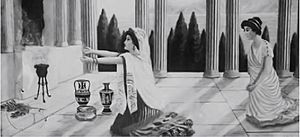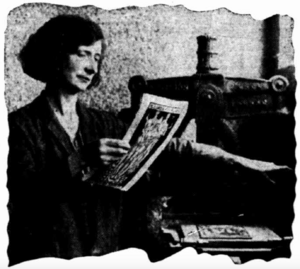Christian Waller facts for kids
Quick facts for kids
Christian Waller
|
|
|---|---|
| Born |
Christian Yandell
2 August 1894 Castlemaine
|
| Died | 25 May 1954 (aged 59) |
| Resting place | Fawkner Crematorium, Melbourne |
| Nationality | Australian |
| Education | National Gallery School |
| Known for | Printmaking, Painting, Stained glass, illustration |
|
Notable work
|
The Great Breath (prints); the Leckie window (University of Melbourne); The Robe of Glory (mural, Fawkner Crematorium) |
| Movement | Arts and Crafts Movement; Theosophy |
| Spouse(s) | Mervyn Napier Waller |
| Patron(s) | Louis Williams [architect] |
Christian Waller (born Christian Yandell, 2 August 1894 – 25 May 1954) was a talented Australian artist. She was known for making prints, illustrating books, painting murals, and creating beautiful stained-glass windows. When she was 15, she moved to Melbourne to study art. In 1915, she married another art student, Mervyn Napier Waller.
Christian Waller was the only professional woman stained-glass artist in Australia for many years. People really wanted her art. After World War I, she had so many requests that she had a five-year waiting list! Her amazing stained-glass windows can be found in over 20 churches across Victoria and New South Wales.
Contents
Christian's Early Life
Christian Waller was born in Castlemaine, Australia. Her parents were Emily and William Yandell. Her father, a plasterer, passed away when she was only five years old. After that, Christian moved to Bendigo to live with her older sister Florence and her husband. She was one of seven children in her family.
How Christian Started Her Art Career
Christian first studied painting in Castlemaine and then in Bendigo. When she was just 14, her painting called A Petition was shown at the Bendigo Art Gallery. People were very impressed, saying she was a "rising artist." The local mayor and a group called the Masonic Lodge helped raise money. They sold her artworks through a special lottery to send her to study art in Melbourne.
In 1910, Christian moved to Melbourne. She studied at the National Gallery School. There, she learned from famous artists like Frederick McCubbin. She won several student awards and showed her art with the Victorian Artists Society. Christian also illustrated many books, including Melba's Gift Book of Australian Art and Literature (1915). In 1916, she married her fellow art student, Mervyn Napier Waller.
During the 1920s, Christian became a top book illustrator. She was the first Australian artist to illustrate Alice in Wonderland in 1924. Her drawings were very creative and unique. Her amazing drawing skills helped support her husband Napier. He was injured in the War and couldn't work for a while.
While at art school, Christian became interested in Theosophy, a spiritual philosophy. She didn't officially join the group, but she read their books and went to their talks. This way of thinking influenced her art and life, even though she also kept her Christian faith.
Christian's Prints and Drawings
Christian Waller was well-known for her strong and bold linocuts. These were prints she made using her own printing press. She often made special bookplates for her friends. Her art was shown in many galleries and was very popular. Her early illustrations were inspired by the "golden age of printmaking" and the Arts and Crafts movement.
Her linocuts often had a stylish Art Deco look. They also included many symbols from old stories, Egyptian beliefs, and even astrology.
One of her most famous works was a series of seven prints called The Great Breath (1932). These prints showed ideas from Theosophy. Art critics really liked them. Christian even produced these prints herself through her own Golden Arrow Press. Only a small number of these special books were made.
She also wrote a second book, The Gates of Dawn, with her own drawings. But she put it aside to help her husband Napier with a big mosaic project. Sadly, she never published it herself. It was later published by her niece, Klytie Pate, in 1977. Christian's prints are known for their complex symbols and bold style. She also planned a third book, but it was never finished.
In 1942, Christian painted a large mural of the Nativity (the birth of Jesus) for a church in Geelong. In 1937, she painted The Robe of Glory mural for the Fawkner Crematorium. By 1948, she had created over fifty stained-glass windows!
Christian's Stained Glass Art
Besides her prints, Christian Waller was a leading artist in stained glass. She and Napier started working for a glass company while they were still students. Christian began taking her own stained-glass orders in 1927. In 1929, they traveled to Europe. They visited famous Arts and Crafts studios in London and Ireland. When she returned, she focused mostly on stained glass, using new techniques she learned.
The architect Louis Williams often hired her for projects. From 1927 to 1953, Christian made more than one hundred individual stained-glass panels. She was very creative and used new methods that were not common in Australia at the time. She did all the work herself, while also helping Napier with his growing mosaic projects.
Christian's stained-glass windows often show her spiritual beliefs from Theosophy. They have rich and complex symbols. Art historian Caroline Miley said that Christian's windows are special because of their original ideas, beautiful colors, and delicate painting. They combine many symbols with a strong personal touch.
You can see large collections of her stained glass at Geelong Grammar School Chapel and other churches in Melbourne. Her designs and drawings for stained glass are also kept in many Australian art galleries.
Christian's Personal Life
In 1915, Christian married Napier Waller, who was also an artist. They lived in a house and studios they designed themselves in Ivanhoe, Melbourne. The couple were part of the lively art scene in Melbourne. Their friends included other artists and musicians.
Christian also mentored a group of young people, whom she called her "children." This group included her niece, Klytie Pate. Christian took care of Klytie from about 1925. She encouraged Klytie's artistic talents, and Klytie became a very important Australian potter. In 2018, the Bendigo Art Gallery held an exhibition called Daughters of the Sun, showing works by both Christian and Klytie.
In 1937, Christian's marriage ended. In 1939, she traveled to New York and joined a spiritual community. She returned to her home in Ivanhoe in 1940. She focused deeply on her art and became more private.
Christian Waller had heart disease but kept working, completing many art orders. She had to stop working in the early 1950s and passed away in 1954, at 59 years old. She was cremated, and her ashes were placed at Fawkner Crematorium. This was the same place where she had painted The Robe of Glory mural years before.
Where to See Christian Waller's Art
Christian Waller's artworks are held in many important collections across Australia:
- National Gallery of Australia: 83 works, plus a portrait of her by Napier Waller.
- The Bendigo Art Gallery: Her self-portrait from 1915.
- Castlemaine Art Museum: 11 works.
- National Gallery of Victoria: 50 works.
- Art Gallery of New South Wales: 4 works.
- Art Gallery of South Australia
- Hamilton Art Gallery
- Ballarat Art Gallery
- Warrnambool Art Gallery
- State Library of Victoria
- State Library of Queensland
Exhibitions
Christian Waller's art has been shown in many exhibitions over the years:
- 1923: Exhibition of Woodcuts in New South Wales.
- 1932: Exhibition of Linocuts in Melbourne.
- Her work has also been featured in many exhibitions after her death, celebrating her important contribution to Australian art. These include:
- 1978: Christian Waller 1895-1956 at Deutscher Galleries.
- 1992: The Art of Christian Waller at Bendigo Art Gallery and Castlemaine Art Gallery.
- 2018-2019: Daughters of the Sun, an exhibition with her niece Klytie Pate, at Bendigo Art Gallery.
See also
- Theosophy and visual arts



